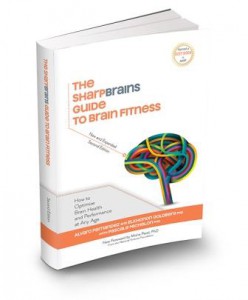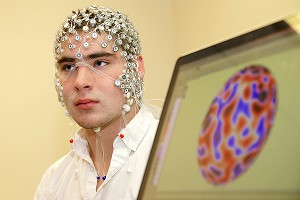Wednesday, July 31, 2013
Friday, July 26, 2013
PEBS Neuroethics Roundup (JHU) [feedly]
Thursday, July 25, 2013
Article: A novel screening method makes it easier to diagnose and treat children with autism
A novel screening method makes it easier to diagnose and treat children with autism
http://medicalxpress.com/news/2013-07-screening-method-easier-children-autism.html
Sent via Flipboard
Wednesday, July 24, 2013
Article: 23 July 2013 - How does the brain change with age? Part #1: Cam-CAN project overview
23 July 2013 - How does the brain change with age? Part #1: Cam-CAN project overview
http://www.bbsrc.ac.uk/news/health/2013/130723-f-ageing-cognition-part1-cam-can-project.aspx
Sent via Flipboard
Tuesday, July 23, 2013
Workouts at the (New Yorker) brain gym [feedly]
 Good article on brain fitness and applied neuroplasticity in the July 29th edition of The New Yorker, featuring many SharpBrains friends. Mentally fit — Workouts at the brain gym:
Good article on brain fitness and applied neuroplasticity in the July 29th edition of The New Yorker, featuring many SharpBrains friends. Mentally fit — Workouts at the brain gym:
"As recently as a few decades ago, most biologists thought that the brain was fully formed during childhood and, like a photograph after it's been developed, was doomed to degrade thereafter, with neurons (nerve cells) fading like pigment on paper until you succumbed to senility. Today, we regard Alzheimer's and other dementias as diseases, rather than as a consequence of normal aging. Moreover, we now consider the brain to be as labile as a digital image in the hands of a Photoshop fiend…Not only does the brain have a lifelong ability to create new neurons; like a government with an unlimited highway budget, it has an endless capacity to build new roadways…The ability of the brain to establish new connections is called plasticity, and brain-fitness exercises are predicated on this mechanism…That's enough science for now. Let's get back to me. . . ."
Monday, July 22, 2013
Article: ISDN2014: 20th Biennial Meeting of the International Society for Developmental Neuroscience
ISDN2014: 20th Biennial Meeting of the International Society for Developmental Neuroscience
http://www.isdn-conference.elsevier.com/
Sent via Flipboard
PEBS Neuroethics Roundup (JHU) [feedly]
Sunday, July 21, 2013
Article: Boosting Cognitive Performance by… Chewing?
Boosting Cognitive Performance by… Chewing?
http://brainblogger.com/2013/07/07/boosting-cognitive-performance-by-chewing/
Sent via Flipboard
Wednesday, July 17, 2013
Brain Exercise Benefits At Any Age [feedly]
-- Read more on ScientificAmerican.com
Tuesday, July 16, 2013
Available: Discussion Guide for The SharpBrains Guide to Brain Fitness [feedly]
 What better way to stimulate our minds than to explore and discuss the latest brain science and how to apply it to improve our health and our lives?
What better way to stimulate our minds than to explore and discuss the latest brain science and how to apply it to improve our health and our lives?
We are pleased to offer a new discussion guide for our new book – The SharpBrains Guide to Brain Fitness: How to Optimize Brain Health and Performance at Any Age (April 2013) — so you can ignite a good conversation with your friends, colleagues, students, in the same way that others at Harvard University, UCLA, the University of Pretoria, The Conference Board, Friends LifeCare, CBCradio, and more, have already started to.
Below, and in this Discussion Guide PDF that you can easily print and share, you will find 20 questions designed to elicit through-provoking conversation on various topics presented in the book. Feel free to pick and choose the questions that seem best suited for your group, and of course do not hesitate to let the discussion guide itself as the conversation starts to get interesting!
QUESTIONS
- Prior to reading this book, what did "Use it or lose it" mean to you? What does it mean to you now?
- What have you learned about your brain that has surprised you the most?
- What have you been doing over the last couple of years to help maintain your brain in top shape?
- How would you define neuroplasticity? And, why does it matter?
- What are some key brain functions to nurture and maintain other than memory? And why may attending to some of these other functions result in a better memory?
- At what age should we start thinking about brain health and fitness? Why?
- Is the brain fitness value of doing 25 crossword puzzles different depending on whether those are our first ever 25 puzzles or whether we already have done 10,000 puzzles before? Why?
- What type of evidence do book authors use to support the book's ideas? Does it seem convincing? Relevant?
- Why is physical exercise good for the brain? How do different types of exercise seem to affect the brain?
- How are your diet and your brain connected? Can you give precise examples of what to do, and what not to do?
- What leisure activities effectively stimulate and challenge the mind? Are crossword puzzles among them? Why or why not?
- Can you explain the mechanisms by which stress may affect the brain and thus cognitive performance? Under what circumstances does stress adversely or beneficially affect the brain?
- How is meditation a kind of brain training? Why do you think the practice is not as widespread as yoga?
- Can you define brain training and compare it to mental stimulation?
- Which of the brain training techniques that you read about in the book stand out most to you?
- Have you tried any of the computerized brain training programs discussed in the book? If so, what has your experience been?
- Which vignette in Chapter 9 did you find most personally relevant and valuable?
- Which interviews did you enjoy the most? Which one left you wanting to learn more, and why?
- How can the growing field of brain fitness affect the way we live our personal and professional lives? How may it affect yours?
- Do you feel better equipped now to understand, navigate and discuss new science and new ways to optimize brain health and performance? How do you plan to stay abreast of this rapidly developing field?
We hope this provides some stimulating summer reading and discussion everywhere where beautiful human brains are to be found
Monday, July 15, 2013
Article: Brain Test to Diagnose A.D.H.D. Is Approved
Brain Test to Diagnose A.D.H.D. Is Approved
http://www.nytimes.com/2013/07/16/health/brain-test-to-diagnose-adhd-is-approved.html
Sent via Flipboard
Article: Brain Test to Diagnose A.D.H.D. Is Approved
Brain Test to Diagnose A.D.H.D. Is Approved
http://www.nytimes.com/2013/07/16/health/brain-test-to-diagnose-adhd-is-approved.html
Sent via Flipboard
Focused, unfocused, and defocused information in working memory. [feedly]
Sunday, July 14, 2013
Article: Between neurohype and neuroskepticism
Between neurohype and neuroskepticism
http://www.doublexscience.org/between-neurohype-and-neuroskepticism/
Sent via Flipboard
Article: Talking ABC... app review: teach kids about the alphabet
Talking ABC... app review: teach kids about the alphabet
http://www.apppicker.com/reviews/8187/Talking-ABC-app-review-teach-kids-about-the-alphabet
Shared from Apps on Flipboard. Download Flipboard for free here.
Article: Crayon Piano: A Piano Based Rhythm and Beat Music app geared toward children
Crayon Piano: A Piano Based Rhythm and Beat Music app geared toward children
http://appchronicles.com/crayon-piano-a-piano-based-rhythm-and-beat-music-app-geared-toward-children/
Shared from Apps on Flipboard. Download Flipboard for free here.
Saturday, July 13, 2013
Article: Breakthrough study reveals biological basis for sensory processing disorders in kids
Breakthrough study reveals biological basis for sensory processing disorders in kids
http://www.sciencedaily.com/releases/2013/07/130709143532.htm
Sent via Flipboard
Thursday, July 11, 2013
Article: Early markers of cognitive enhancement: developing an implicit measure of cognitive performance - Online First
Early markers of cognitive enhancement: developing an implicit measure of cognitive performance - Online First
http://link.springer.com/article/10.1007/s00213-013-3186-6
Sent via Flipboard
Wednesday, July 10, 2013
The Importance of Sensory Integration Therapy [feedly]
Sensory integration therapy (SIT) has been one of the treatment mainstays for thousands of children diagnosed with autism spectrum disorders, ADD/ADHD, or other developmental disorders. According to the American Occupational Therapy Association (AOTA), approximately 5 to 15% of children in the general population have sensory processing issues.School-based and private occupational therapists and parents have brushed, swung, and bounced on balls countless children in an effort to improve their ability to process sensory input. Yet, the effectiveness of this therapy, despite accolades it has received from therapists and parents, has been questioned. Now a new study by Lang et al that assesses the benefits of SIT by reviewing 25 existing studies adds additional fuel to the debate. In a nutshell, the study authors state that SIT is neither effective nor research-based and that agencies (such as schools) that are mandated to provide research-based interventions should not be using SIT.
Lang et al culled electronic data bases for different studies that purported to measure the effectiveness of SIT. To be included in the Lang review, the study had to meet certain inclusion criteria; namely, at least one participant had to be diagnosed with an ASD and some form of SIT had to be implemented in an effort to ameliorate the symptoms of the ASD. The SIT was then classified as positive, negative, or mixed depending on its effectiveness. Additionally, the methodological rigor of the study was examined to determine if the study had a true experimental design that among other things could be replicated.
Of the 25 studies included in the review, 3 suggested that SIT was effective, 8 had mixed results, and 14 showed no improvement related to SIT. The study authors went on to state that many of the studies reviewed, including the three with positive results, had serious methodological flaws.
Not surprisingly, the AOTA has come back pretty hard denouncing this review by Lang et al. SIT, according to the AOTA, needs to be tailored very specifically to the child and offered for prolonged periods of time. The SIT used in all 14 of the studies that Lang et al rated ineffective was neither performed appropriately nor in the recommended time frame to be effective, according to the AOTA. Additionally, in a number of those studies that had positive or mixed results, the SIT was used more appropriately, according to the AOTA. With regards to study methodology, the AOTA argues that just because a study's methodology is weak does not mean the SIT was ineffective. More rigorous study may be needed, but researchers need to recognize that the lack of homogeneity in children with ASDs and the need to individuate SIT treatments make it very difficult to design controlled studies.
The American Academy of Pediatrics had jumped into this argument last spring in a policy statement on sensory integration therapies, which adopts a more middle of the road approach. According to the AAP, "Occupational therapy with the use of sensory-based therapies may be acceptable as one of the components of a comprehensive treatment plan." However, the AAP suggests that pediatricians need to discuss with parents the limitations of the research involving the effectiveness of SIT and work with families on how to determine if the SIT is working for their child or not.
Some school districts may perhaps use the Lang study as a justification for removing SIT from their special education programs, since Lang declared it was not research-based, as required by IDEA and NCLB. So, where does this leave children with ASD and other disabilities and their parents? In my experience over the last several years more districts are seeing the benefits of sensory integration, althought the effectiveness of the providers is very broad. Hopefully this study will not move things in the wrong direction. Students need all the tools arrayed in their favor including SIT.
Introducing an instrument to assess time orientation and time relation in adolescents [feedly]
Author(s): Mello, Zena R.; Finan, Laura J.; Worrell, Frank C.
Source: JOURNAL OF ADOLESCENCE, 36 (3): 551-563 JUN 2013
IDS#: 163PZ. ISSN: 0140-1971
Tuesday, July 09, 2013
Nebraska football team developing 10-minute concussion test [feedly]
 Nebraska to study concussions (ESPN):
Nebraska to study concussions (ESPN):
"…the day is coming when a football player who takes a hit to the head will come to the sideline, take off his helmet and slip on an electrode-covered mesh cap…The team's medical staff will analyze the player's brain waves on the spot and determine within minutes whether he can safely return to the game or whether he has sustained a concussion and, if so, how severe.
"There's no question it's going to move the dial forward," NCAA chief medical officer Brian Hainline said. "The big, hoped-for dream would be, let's have a biomarker in brain imaging. If you're to the left of that, you're safe; if you're to the right of it, you're not. That's probably a few years out. But functional brain imaging and blood flow are going to be a very important part of that."
Related article:
Article: Computerized memory training lead... [Am J Intellect Dev Disabil. 2013] - PubMed
Computerized memory training lead... [Am J Intellect Dev Disabil. 2013] - PubMed
http://www.ncbi.nlm.nih.gov/pubmed/23734613
Sent via Flipboard
Sunday, July 07, 2013
PEBS Neuroethics Roundup (JHU) [feedly]
Saturday, July 06, 2013
Article: Frontiers | The largest human cognitive performance dataset reveals insights into the effects of lifestyle factors and aging
Frontiers | The largest human cognitive performance dataset reveals insights into the effects of lifestyle factors and aging
http://www.frontiersin.org/human_neuroscience/10.3389/fnhum.2013.00292/full
Sent via Flipboard
Article: The Esoteric Significance of the Cerebellum, Part 1
The Esoteric Significance of the Cerebellum, Part 1
http://humanityhealing.net/2013/07/the-esoteric-significance-of-the-cerebellum-i/
Sent via Flipboard
Friday, July 05, 2013
Article: New study sheds light on exercise's impact on brain
New study sheds light on exercise's impact on brain
http://www.cbsnews.com/8301-505269_162-57592433/new-study-sheds-light-on-exercises-impact-on-brain/
Sent via Flipboard
Reading or watching TV tonight? [feedly]
 Being a Lifelong Bookworm May Keep You Sharp in Old Age (Smithsonian.com):
Being a Lifelong Bookworm May Keep You Sharp in Old Age (Smithsonian.com):
"…findings, published online today in Neurology, suggest that reading books, writing and engaging in other similar brain-stimulating activities slows down cognitive decline in old age, independent of common age-related neurodegenerative diseases. In particular, people who participated in mentally stimulating activities over their lifetimes, both in young, middle and old age, had a slower rate of decline in memory and other mental capacities than those who did not…
Reading gives our brains a workout because comprehending text requires more mental energy than, for example, processing an image on a television screen."
Study: Life-span cognitive activity, neuropathologic burden, and cognitive aging (Neurology). From the Abstract:
- Objective: To test the hypothesis that cognitive activity across the life span is related to late-life cognitive decline not linked to common neuropathologic disorders.
- Methods: On enrollment, older participants in a longitudinal clinical-pathologic cohort study rated late-life (i.e., current) and early-life participation in cognitively stimulating activities. After a mean of 5.8 years of annual cognitive function testing, 294 individuals had died and undergone neuropathologic examination. Chronic gross infarcts, chronic microscopic infarcts, and neocortical Lewy bodies were identified, and measures of β-amyloid burden and tau-positive tangle density in multiple brain regions were derived.
- Conclusions: More frequent cognitive activity across the life span has an association with slower late-life cognitive decline that is independent of common neuropathologic conditions, consistent with the cognitive reserve hypothesis.
Wednesday, July 03, 2013
NIH Director’s Award Winner to speak at 2013 SharpBrains Summit [feedly]
 We're glad to announce one more excellent speaker at the 2013 SharpBrains Virtual Summit, September 19-20th.
We're glad to announce one more excellent speaker at the 2013 SharpBrains Virtual Summit, September 19-20th.
A Professor of Psychiatry at Yale University, Dr. Bruce Wexler won the NIH Director's Award for high impact, high innovation, paradigm changing medical research, 2012–2016. Dr. Wexler is founder and chief scientist of C8 Sciences, one of the 10 Companies to Watch in 2013/ 2014 according to our latest market report. He created C8 Kids, a brain-based content-independent pedagogy to directly improve thinking abilities in 5–9 year old children, combining computer presented brain exercises with physical exercises. He is also the director of the Neurocognitive Research Laboratory at the Connecticut Mental Health Center, and a facilitator for the Council of Religious Institutions of the Holy Land, designing and managing a U.S. State Department funded study of how "the other" is portrayed in Israeli and Palestinian school books.
–> To Learn More and Register, please click on 2013 SharpBrains Virtual Summit (10% off discount code: sharp2013)
Article: Emotional Cues Alter Perceptions of Time and Number
Emotional Cues Alter Perceptions of Time and Number
http://www.psychologicalscience.org/index.php/publications/observer/obsonline/emotional-cues-alter-perceptions-of-time-and-number.html
Sent via Flipboard
Tuesday, July 02, 2013
Individual differences in the gesture effect on working memory [feedly]
Author(s): Marstaller, Lars; Burianova, Hana
Source: PSYCHONOMIC BULLETIN & REVIEW, 20 (3): 496-500 JUN 2013
IDS#: 155SI. ISSN: 1069-9384
Sensorimotor synchronization: A review of recent research (2006-2012) [feedly]
Author(s): Repp, Bruno H.; Su, Yi-Huang
Source: PSYCHONOMIC BULLETIN & REVIEW, 20 (3): 403-452 JUN 2013
IDS#: 155SI. ISSN: 1069-9384
Article: Time perception altered by mindfulness meditation
Time perception altered by mindfulness meditation
http://medicalxpress.com/news/2013-06-perception-mindfulness-meditation.html
Sent via Flipboard
Monday, July 01, 2013
Sustaining attention to simple tasks: A meta-analytic review of the neural mechanisms of vigilant attention. [feedly]
The 100 most followed psychologists and neuroscientists on Twitter [feedly]
Richard Wiseman. Parapsychologist. Followers: 121261
Laura Kauffman. Child psychologist. Followers: 106623
Steven Pinker. Psycholinguist, evolutionary psychologist, author. Followers: 74775
George Huba. Psychologist. Followers: 53644
Leah Klungness. Author and psychologist. Followers: 53063
Dolors Reig. Social psychologist (tweets in Spanish). Followers: 51383
Dan Ariely. Behavioural Economist, author. Followers: 49533
Jonah Lehrer. Writer, blogger. Followers: 46259
Marsha Lucas. Neuropsychologist. Followers: 31273
BPS Research Digest. The BPS Research Digest! Followers: 30007
Melanie Greenberg. Clinical health psychologist. Followers: 28104
Aleks Krotoski. Psychologist, tech journalist. Followers: 22583
Neuroskeptic. Blogger and neuroscientist. Followers: 19851
Jo Hemmings. Celebrity psychologist. Followers: 19548
Vaughan Bell. Clinical neuropsychologist, blogger. Followers: 17992
Melissa McCreery. Clinical Psychologist. Followers: 17289
Richard Thaler. Behavioural economist. Followers: 16709.
Jeremy Dean. Blogger. Followers: 16404
Mo Costandi. Writer, blogger. Followers: 15689
David Eagleman. Neuroscientist, author. Followers: 15509
David Ballard. Psychologist, Head of APA marketing. Followers: 14479
The Psychologist magazine. Followers: 14176
BPS Official. Followers 14169
Anthony Risser. Neuropsychologist, blogger. Followers: 13245
Daniel Levitin. Psychologist, author. Followers: 12985
Honey Langcaster-James. Psychologist and coach. Followers: 11291
Sarah-Jayne Blakemore. Cognitive neuroscientist. Followers: 10373
Ciaran O'Keeffe. Parapsychologist. Followers: 10251
Dorothy Bishop. Developmental neuropsychologist. Followers: 9976
Petra Boynton. Psychologist, sex educator. Followers: 9895
Jay Watts. Clinical psychologist, Lacanian. Followers: 8719
David Webb. Psychology tutor, blogger. Followers: 7851
Uta Frith. Developmental neuropsychologist, autism expert. Followers: 7774
Simon Baron-Cohen. Developmental psychologist. Followers: 7383
Graham Jones. Internet (cyber) psychologist. Followers: 7255
Christian Jarrett. Psychologist and writer/editor. Followers: 7135
Margarita Holmes. Psychologist and sex therapist. Followers: 7053
Cary Cooper. Occupational psychologist. Followers: 6876
Bruce Hood. Cognitive scientist. Followers: 6814
Susan Weinschenk. Psychologist and author. Followers: 6561
Todd Finnerty. Psychologist. Followers: 5783
Bradley Voytek. Neuroscientist and self-professed geek. Followers: 5775
Miriam Law-Smith. Clinical evolutionary psychologist. Followers: 5700
Claudia Hammond. Radio presenter. Followers: 5661
John Grohol. Founder of Psychcentral. Followers: 5612
Jason Goldman. Grad student, blogger. Followers: 5382
G. Tendayi Viki. Social psychologist. Followers: 5224
Jon Sutton. Editor of The Psychologist. Followers: 4448
Marco Iacoboni. Neuroscientist, mirror neuron expert. Followers: 4396
Jesse Bering. Psychologist, blogger. Followers: 4154
Rita Handrich. Psychologist, editor. Followers: 4152
Sandeep Gautam. Blogger. Followers: 4022
Steven Brownlow. Clinical and forensic psychologist. Followers: 3979
Joseph LeDoux. Neuroscientist, rocker. Followers: 3911
The Neurocritic. Blogger. Followers: 3894
Chris French. Anomalistic psychologist. Followers: 3818
Lyle Becourtney. Specialist in anger management. Followers: 3739
Mark Changizi. Cognitive psychologist, author. Followers: 3610
Charles Fernyhough. Developmental psychologist, author. Followers: 2545
Pam Dodd. Organisational psychologist. Followers: 3321
Maria Panagiotidi. Grad student. Followers: 3263
John Cacioppo. Psychologist, social neuroscientist. Followers: 3133
Daniel Simons. Cognitive psychologist, author. Followers: 3285
Scott Kaufman. Cognitive psychologist. Followers: 3190
Rory O'Connor. Health psychologist, suicide researcher. Followers: 3162
Brian MacDonald. Clinical psychologist. Followers: 3015
Wendy Cousins. Psychologist and skeptic. Followers: 2881
Chris Atherton. Cognitive psychologist. Followers: 2718
Rebecca Symes. Sports psychologist. Followers: 2559
Andrew and Sabrina. Psychological scientists. Followers: 2540
BPS Occupational Digest. The BPS Occupational Digest. Followers: 2497
Atle Dyregrov. Psychologist, expert in crisis psychology. Followers: 2381
Ana Loback. Psychologist. Followers: 2348
Fretes Torruella. Educational psychologist (tweets in Spanish and English). Followers: 2301
Tom Stafford. Psychologist, author. Followers: 2298
Jon Simons. Cognitive scientist. Followers: 2151
Jon Brock. Autism blogger, wannabe neuroscientist. Followers: 2125
Tom Hartley. Neuroscientist. Followers: 2030
Rolfe Lindgren. Psychologist, personality expert. Followers: 1860
Wray Herbert. Writer for APS, author. Followers: 1859
Rob Archer. Organisational psychologist. Followers: 1781
Michelle Dawson. Autistic researcher. Followers: 1666
Alex Linley. Positive psychologist. Followers: 1611
Manon Eileen. Clinical psychologist and criminologist. Followers: 1595
Michael Hogan. Psychologist and neuroscientist. Followers: 1570
Karen Pine. Psychologist, author. Followers: 1546
Monica Whitty. Cyberpsychologist. Followers: 1543
Ioannis Nikolaou. Organisational psychologist (tweets in Greek and English). Followers: 1534
David Matsumoto. Psychologist and judoka. Followers: 1527
Victoria Galbraith. Counselling psychologist. Followers: 1482
Dave Brodbeck. Comparative cognition and evolutionary psychologist. Followers: 1474
Christine Allen. Clinical psychologist and executive coach. Followers: 1470
Daryl O'Connor. Health psychologist. Followers: 1470
Peter Kinderman. Clinical psychologist. Followers: 1464
Jonathan Firth. Psychology teacher and author. Followers: 1393
Voula Grand. Psychologist and writer. Followers: 1355
Ciaran Mc Mahon. Psychologist. Followers: 1304
If we've missed any psychologists or neuroscientists who should be in the top 100 please let us know via comments and we'll add them in.
--Thanks to Emma Smith for compiling the update.



